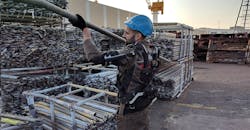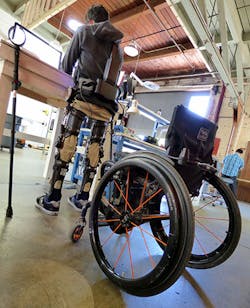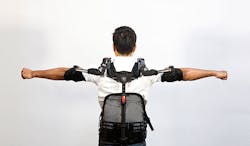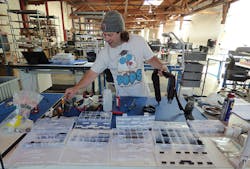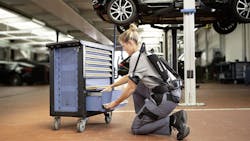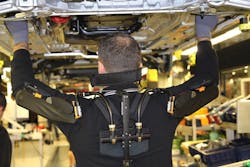It's 2019 and the workforce burdens bearing down on plant managers and supervisors are heavy enough to make Atlas break a sweat. They can't find the right people who are both willing and educated, or the best people had to go and do a stupid thing like get old. Or even worse, suffer a musculoskeletal injury on the job.
In Q1 of this year, one out of every four manufacturers turned down new business opportunities because they lacked the workers, according to the National Association of Manufacturing. Nearly every company is vulnerable, every factory susceptible, even highly automated plants run by genius billionaire philanthropists.
Last year Tesla CEO Elon Musk tweeted: "Yes, excessive automation at Tesla was a mistake. To be precise, my mistake. Humans are underrated."
Fortunately, Homayoon Kazerooni, a brilliant Iranian engineer who immigrated to the U.S. right before the Ayatollah took over, has always sought to bring out the best in humanity. He's done it through decades of research into functional exoskeletons, wearable devices that mechanically enhance human movement, from locomotion to lifting—using robots to pick up the slack for our areas of weakness.
"The writing was on the wall 20 years ago," Kazerooni laments. "Robots cannot replace people. We just cannot wait for the robots to show up. We need to come up with solutions for workers right now."
The professor at the University of California, Berkeley started by developing powered lower-body exoskeletons for soldiers hauling heavy loadouts, then transitioned to motorized leg braces that allow paraplegics to stand upright and walk.
Kaz, as he likes to be called, founded two of the leading manufacturers of these medical devices, first at Ekso Bionics and currently SuitX (where he is CEO). They are two of the four devices in the world approved by the FDA. For just this work alone, his (unofficial) title as Father of Exoskeletons would be secure, but in the last half of this decade Ekso and SuitX have developed industrial exoskeletons as the potential solution to all those workforce-related anvils resting on the chest of companies requiring manual labor.
They may raise their arms 4,600 times a day, which increases the risk for those expensive shoulder injuries, like a rotator cuff tear.
EksoVest alleges to relieve strain best when lifting 5 to 15 lb. per arm, such as an impact drill or piece of paneling. So far, the evidence seems to support their usefulness.
They are looking for decreases in effective discomfort, muscle activity and an increase in endurance.
At SuitX headquarters in Emeryville, Calif., which serves as the assembly plant, office and lab, Steven Sanchez performs the dual role of chief pilot of the Phoenix medical exoskeleton and overall product quality inspector.
"We've seen significant decreases in discomfort in upper limbs and upper back," Smets says.
This is not enough to sell Smets just yet, though.
"That’s all well and good," he says, "What I don’t know, and what the world doesn’t know yet, is will it mean in two years that I will have fewer injuries on my line?"
That is the root of what Smets, and every exoskeleton user, wants to know. They won’t find out if users won’t wear them for two hours, let along two years.
"If they don’t find perceived value, they might not wear it," Smets says, "and if there is any perceived discomfort, you're going to dust it."
That's why at Michigan Assembly Plant, which underwent an overhaul for the new Ranger truck, Ford is offering their brand-new operators the chance to select their own exoskeleton that fits them best. It makes sense as they are all about the same price point ($5,000-7,000) and you wouldn’t mandate every worker wear the same size safety shoe.
"We're hoping giving them a choice like this it will increase their utilization," says Smets.
"There's a lot still to learn and the problem is every new device is different," Smets says. "What I am becoming more sure of in this wearable space is we can't count on one product to solve all problems."
Down with PPE
While Ford has methodical, err-on-the-side-of-caution approach, Toyota has already made Levitate Technologies' Airframe exoskeletons mandatory at two of their North American plants for overhead work: Woodstock, Ont., and Princeton, Ind., which assembles 400,000 SUVs and minivans a year.
The Woodstock, Ont. Plant, where the RAV4 is built, has 150 devices for use in weld shop inspections. There are more than 200 in use at the Princeton, Indiana, plant, which assembles 400,000 SUVs and minivans a year. Levitate had already earned the CE marking for PPE in Europe and has been used at BMW's Spartanburg, S.C. plant since 2016. Ford also used them at powertrain, engines and transmission plants. The device, which is in more than 100 enterprises globally, had also already demonstrated its ability to prevent fatigue, based on data collected on a Lincoln Electric VRTEX 360 welding simulator, thus keeping weld quality consistent for a longer period.
[Correction: A previous version said the Ottobock Paexo weighs 4.5 lb. the company says it weighs 3.9. lb.]
About the Author
John Hitch
Editor, Fleet Maintenance
John Hitch, based out of Cleveland, Ohio, is the editor of Fleet Maintenance, a B2B magazine that addresses the service needs for all commercial vehicle makes and models (Classes 1-8), ranging from shop management strategies to the latest tools to enhance uptime.
He previously wrote about equipment and fleet operations and management for FleetOwner, and prior to that, manufacturing and advanced technology for IndustryWeek and New Equipment Digest. He is an award-winning journalist and former sonar technician aboard a nuclear-powered submarine where he served honorably aboard the fast-attack submarine USS Oklahoma City (SSN-723).
